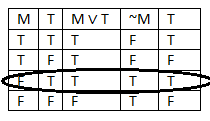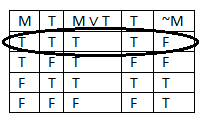A Lesson in Logic
Last week I covered a different kind of syllogism, the hypothetical syllogism, which used the material conditional to essentially extend an implication. The disjunctive version is probably more common, which I think will become apparent early on. As you might imagine, it involves the use of disjunction. Anyway, onward into logical lands!
Let’s start with our example:
- The cat is on the mat or the cat is in a tree. (M ∨ T)
- The cat is not on the mat. (~M)
- Therefore, the cat is in a tree. (Therefore T)
 If you remember disjunction, you’ll remember that for it to be true, one or the other of the options has to be true. The syllogism shows that, since one of the options is false, the other has to be true. And that’s it. If you can show one side of a true disjunction is false, then the other one is true. As you can see from the truth table, if the both the premises are true, the conclusion is true.
If you remember disjunction, you’ll remember that for it to be true, one or the other of the options has to be true. The syllogism shows that, since one of the options is false, the other has to be true. And that’s it. If you can show one side of a true disjunction is false, then the other one is true. As you can see from the truth table, if the both the premises are true, the conclusion is true.
Now, you might ask, why do we have to show that one is false? Why can’t we reverse it, and like this:
- The cat is on the mat or the cat is in a tree. (M ∨ T)
- The cat is in a tree. (T)
- Therefore, the cat is not on the mat. (Therefore ~M)
 It’s a good question, but we can’t do that because a disjunction is also true if both sides of it are true. If you look at the truth table for this, you can see that it’s possible for all of the premises to be true, but for the conclusion to be false. This is called “Affirming the alternative”and constitutes a counterexample, which shows that the argument form is invalid. The conclusion doesn’t follow necessarily from the premises. In Line 4 of the table, you can see that the premises and conclusion can all be true, but the conclusion isn’t true because of the premises, but rather by coincidence.
It’s a good question, but we can’t do that because a disjunction is also true if both sides of it are true. If you look at the truth table for this, you can see that it’s possible for all of the premises to be true, but for the conclusion to be false. This is called “Affirming the alternative”and constitutes a counterexample, which shows that the argument form is invalid. The conclusion doesn’t follow necessarily from the premises. In Line 4 of the table, you can see that the premises and conclusion can all be true, but the conclusion isn’t true because of the premises, but rather by coincidence.
Do these arguments happen in the real world? All over the place. Today’s great example of a bad disjunctive syllogism comes from Geraldo Rivera who, in response to the shooting of Trayvon Martin said, “The hoodie killed Trayvon Martin as surely as George Zimmerman.” Here’s a link to an article on it in the Huffington Post. The relevant details of the case are that Trayvon was walking through a neighborhood armed with skittles and iced tea, and was shot dead by overzealous self-appointed watchman George Zimmerman, who routinely carries a concealed 9mm pistol. And Zimmerman wasn’t arrested. It’s a complex case, but let’s look at Geraldo’s remark. Most people, especially with the 911 tapes coming out in court, are saying the killing is because of racism. But Geraldo doesn’t think so. So, hoodie or racism?
- Travyon died because he wore a hoodie or he died because of Zimmerman’s racial profiling. (H ∨ R)
- Trayvon didn’t die because of Zimmerman’s racial profiling (~R)
- Therefore, Trayvon died because he wore a hoodie. (H)
Now, let’s give Geraldo some credit. This is a valid argument. It fits the exact form required for a disjunctive syllogism. But is it sound? Remember, a sound argument has to be valid, and all of the premises have to be true. The 911 tapes have a lot to say about falsifying premise 2 though (from CNN). And if premise 2 is false, then the conclusion doesn’t follow. Sorry Geraldo. Hoodies? Really? Anyway, thanks for reading, and come back on Wednesday for a post about the Prisoner’s Dilemma, or Saturday for more logic.

????????????????????
??????????????? ???????? ????? ????? ????6????? L3000207 ??? ???? ?????? ?????? ??? 6?? 6??????? ? ??? ? 150507039 Cartier
???????????
????????????????????
????????????N?????????????????????????????????????????????????????????????????IWC ?????????????????????????????????????????????????????????????? https://www.tentenok.com/product-8874.html